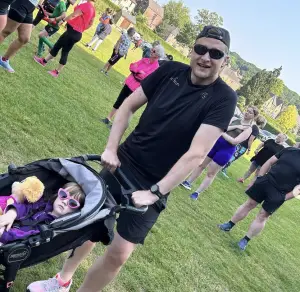If you’re looking to get into running or want to challenge yourself to complete your first 5km run, you’re in the right place.
One of the best ways to run a 5km is parkrun, it’s weekly on a Saturday and totally free. There are plenty in the UK and a growing number in the United State and Canada. Check out the parkrun website here.
Running 5km might seem daunting at first, but with the right training plan and mindset, you can achieve this goal. This article will provide a training plan to help you prepare for your first 5km.
Before we dive into the training plan, it’s important to note that running your first 5km requires commitment and consistency. You’ll need to set aside time for training and be willing to push yourself out of your comfort zone. However, you’ll be amazed at what you can achieve with the right approach.
Our training plan is designed for beginners and assumes you have little or no running experience. It’s a 6-week plan that gradually builds up your endurance and prepares you for the 5km race. Whether you’re aiming to run the entire distance or a combination of running and walking, our plan can be adapted to suit your needs. So, let’s get started!
Setting Realistic Goals
Understanding Your Current Fitness Level
Before embarking on a training plan for your first 5km, assessing your fitness level is important. This will help you set realistic goals and avoid injury. You can start by asking yourself:
- How often do I exercise?
- What type of exercise do I do?
- What is my current running ability?
- What is my current endurance level?
Once you have answered these questions, you can use them to determine your starting point and adjust your training plan accordingly.
Defining Your Goals
Defining your goals is crucial to your success in completing your first 5km. When setting your goals, it is important to make them specific, measurable, achievable, relevant, and time-bound. Here are some examples of SMART goals:
- Run a 5km race in 8 weeks
- Run for 30 minutes without stopping in 4 weeks
- Improve my pace by 1 minute per km in 12 weeks
Remember, your goals should be challenging but achievable. Setting unrealistic goals can lead to frustration and injury.
Building Your Endurance
Start with Walking
Walking is a great way to start your training plan. It is low-impact and will help you build up your endurance gradually. Start with a brisk walk for 20-30 minutes, three times a week. You can also incorporate hills or stairs to add some intensity to your walking workout. Remember to warm up before you start and cool down after you finish.
Alternate Walking and Running
Once you feel comfortable with walking, it’s time to start introducing running into your routine. Start by alternating walking and running for short periods of time. For example, walk for three minutes and then run for one minute. Gradually increase the amount of time you spend running and decrease the amount of time you spend walking until you can run for 30 minutes straight.
Increase Your Running Time
As you progress in your training, you can start increasing the time you spend running. Aim to add 5-10 minutes to your running time each week. Don’t forget to take rest days to allow your body to recover. You can also incorporate interval training, where you run at a faster pace for short periods of time, to help improve your endurance.
Remember, building endurance takes time and consistency. Stick to your training plan and celebrate your progress along the way!
Strengthening Your Body
Before you start running, preparing your body with strength and flexibility training is important. This will help prevent injury and improve your overall performance. Here are two types of training you should include in your plan:
Strength Training
Strength training will help improve your overall body strength, which is important for running. Here are some exercises you can do:
- Squats
- Lunges
- Planks
- Push-ups
- Deadlifts
Try to do these exercises at least twice a week, with a day of rest in between. Start with 2-3 sets of 10-12 reps, and gradually increase the weight or reps as you get stronger.
Flexibility Training
Flexibility training will help improve your range of motion and prevent injury. Here are some stretches you can do:
| Stretch | How to do it |
|---|---|
| Hamstring stretch | Sit on the floor with your legs straight out in front of you. Reach forward and try to touch your toes. |
| Quad stretch | Stand up straight and grab your ankle with one hand. Pull your heel towards your butt. |
| Calf stretch | Stand facing a wall with one foot forward and one foot back. Lean forward and push against the wall with your back foot. |
| Hip flexor stretch | Kneel on one knee with your other foot in front of you. Lean forward until you feel a stretch in your hip. |
Try to do these stretches after every workout, and hold each stretch for 15-30 seconds.
Fueling Your Body
When running, it’s important to fuel your body properly. Eating the right foods and staying hydrated can help you perform at your best and avoid injury. Here are some tips on how to fuel your body for your first 5km:
Hydration
Staying hydrated is crucial for runners. Dehydration can lead to fatigue, cramps, and other issues derailing your training. Here’s how to stay hydrated:
- Drink water throughout the day, not just during your runs.
- Carry a water bottle with you during your runs and sip regularly.
- Consider drinking an electrolyte drink during longer runs to replenish lost minerals.
Nutrition
Eating the right foods can help you fuel your runs and recover properly. Here are some tips on how to eat for your runs:
| Before Your Run | During Your Run | After Your Run |
|---|---|---|
| Carb-rich meal 2-3 hours before your run | Sip on an electrolyte drink or eat an energy gel if running for longer than an hour | Protein-rich meal within 30 minutes of finishing your run |
| Avoid heavy or high-fat meals before your run | Focus on easily digestible carbs during your run, such as sports drinks or gels | Replenish lost fluids and electrolytes with a sports drink or water |
| Stay hydrated with water or a sports drink | Avoid trying new foods or drinks during your run | Include some carbs in your post-run meal to aid in recovery |
Remember, everyone’s nutritional needs are different, so it’s important to experiment and find what works best for you. Be sure to listen to your body and adjust your diet accordingly.
Staying Motivated
Running can be challenging, but it can also be incredibly rewarding. Here are some tips to help you stay motivated as you work towards your first 5km.
Find a Running Buddy
Having a running buddy can be a great way to stay motivated. You can encourage each other, hold each other accountable, and make the whole experience more enjoyable. Find someone with similar goals and pace, and commit to running together regularly.
Join a Running Group
If you want more social support, consider joining a running group. You’ll meet other runners who share your passion, and you’ll have access to group runs, training plans, and other resources. Look for a group that fits your schedule and your level of experience.
Use a Running App
There are many running apps available that can help you stay motivated and track your progress. Some apps offer training plans, while others allow you to connect with other runners or track your runs using GPS. Find an app that fits your needs and use it to set goals, monitor your progress, and stay motivated.
Preparing for the Race Day
Get Enough Rest
It is crucial to get enough rest before the race day. Aim to get at least 8 hours of sleep the night before the race. This will help you feel refreshed and energized on the day of the race. Avoid staying up late or doing anything that might disrupt your sleep, such as drinking caffeine or alcohol.
Dress Appropriately
Make sure you wear comfortable clothing and shoes that are suitable for running. Choose moisture-wicking fabrics that will keep you dry and comfortable throughout the race. Avoid wearing new shoes or clothes on race day, as they may cause discomfort or chafing.
Warm-Up and Cool-Down
Before the race, it is essential to warm up your muscles to prevent injury and improve performance. A proper warm-up should include light jogging, stretching, and dynamic exercises such as lunges and high knees. After the race, take some time to cool down by walking or jogging slowly and stretching your muscles.
Remember that preparing for a 5km race takes time and effort. Follow a training plan, get enough rest, eat a balanced diet, and stay hydrated. With dedication and perseverance, you can achieve your goal of running your first 5km race.
Conclusion
Congratulations on completing your first 5km training plan! You should be proud of your hard work and commitment to your fitness goals.
Remember that running is a journey, and there will be ups and downs along the way. Be sure to listen to your body and adjust your training plan as needed to avoid injury or burnout.
As you continue to run, consider setting new goals for yourself, such as running a 10km or completing a race. Don’t be afraid to challenge yourself, but also be realistic about what you can achieve.
Finally, remember that running is not just about physical fitness, but also mental and emotional wellness. Take time to enjoy the process and appreciate the benefits that running can bring to your life.


